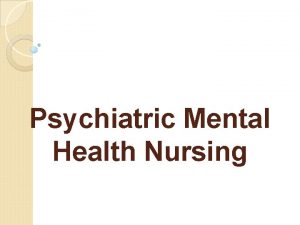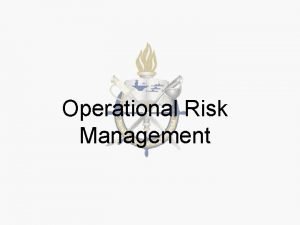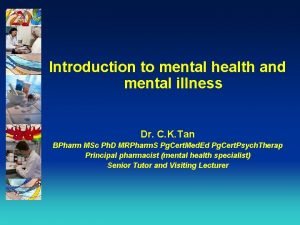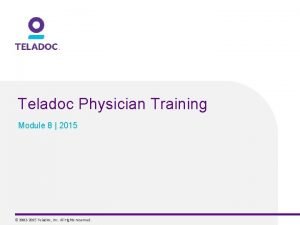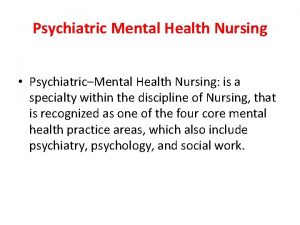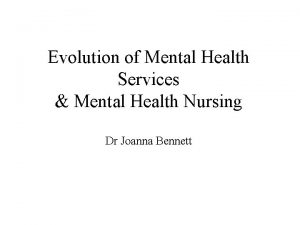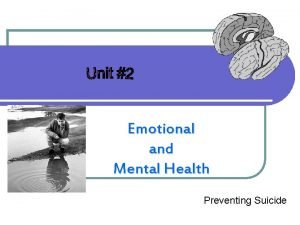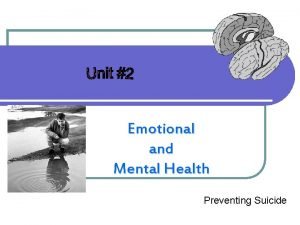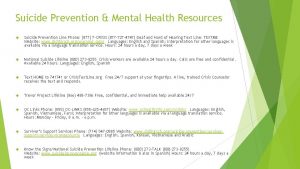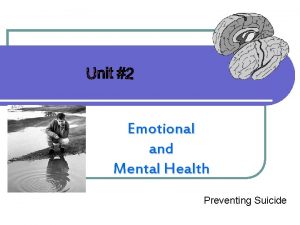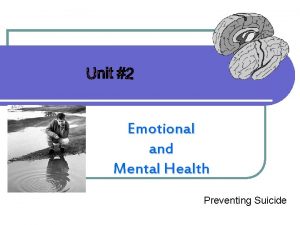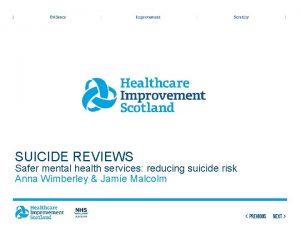SUICIDE NSC 402 MENTAL HEALTH NURSING INTRODUCTION Suicide





















- Slides: 21

SUICIDE NSC 402 MENTAL HEALTH NURSING

INTRODUCTION Suicide is the intentional act of killing oneself. Suicide is as an act with a fatal outcome that is deliberately initiated and performed by the person in the knowledge or expectation of its fatal outcome. It is a self-directed injurious behavior with any intent to die as a result of the behavior

INTRD (End) It is a Latin language ‘sui’ (oneself) and ‘caedes’ (killing) suicide constitutes all cases of death directly or indirectly resulting from act of a person who is aware of the consequences of the behavior. Primary emergency for mental health professional. Major public health problem.

The Suicidal Client Suicidal ideation- thinking about killing oneself. Active suicidal ideation- patient thinks about and seeks ways to commit suicide. Passive suicidal ideation- patient thinks about wanting to die or wishes he or she were dead but has no plans to cause his or her death. Attempted suicide is a suicidal act that either failed or was incomplete.

Causes/Risk factors Genetic factors: Polymorphism in TPH gene (tryptophan hydroxylase enzyme) Gender differences: Men 4 times > Women Age: Increase with age men peak age- after 45 years women – 55 years Religion: Degree of orthodoxy and integration. Marital status- lessens the risk Occupation- higher social status greater the risk unemployed > employed Physical health- loss of motility disfigurement, chronic intractable pain patients on hemodialysis Drugs : Reserpine, corticosteroids, anti-cancer agents

Causes/Risk factors Recent or serious loss Mental disorders (particularly mood disorders) Hopelessness, helplessness, guilt, worthlessness Previous suicide attempt Alcohol and other substance use disorders Disciplinary problems Sexual orientation confusion

Risk factors (Social/situational) Recent or serious loss (e. g. , death, divorce, separation, broken relationship; self-esteem; loss of interest in friends, hobbies, or activities previously enjoyed) Family history of suicide Witnessing family violence Child abuse or neglect Lack of social support Sense of isolation Victim of bullying or being a bully

Risk factors (Cultural/environmental) Access to lethal means (i. e. firearms, pills) Stigma associated with asking for help Barriers to accessing services Unreliable transportation Financial costs of services Cultural and religious beliefs (e. g. , belief that suicide is noble resolution of a personal dilemma)

THE SUICIDAL CLIENT • Clients with psychiatric disorders especially depression, bipolar disorder, schizophrenia, substance abuse, post-traumatic stress disorder, and borderline personality disorder are at increased risk for suicide • Though common in people with mood disorders, especially depression. • Almost 95 percent of all people who commit or attempt suicide have a diagnosed mental disorder. • Depressive disorders account for 80 percent of this figure.

Facts About Suicide Asking about suicide does not make a person suicidal. If you think a person is suicidal, then ask them Most people who commit suicide have a previous history of self-harm Suicide involves ambivalence: people who are considering suicide have mixed feelings Many people who attempt or complete suicide give out warnings or clues Most people who commit suicide have a plan

Clues Given by Suicidal Patients Personal items may be given away a sense of calm may indicate that the final plan is in place Wills may be completed or letters sent Statements of a desire to die, of hopelessness, and of a will to kill themselves may be overtly expressed. All such warnings need to be received seriously.

Types of Suicide Egoistic - This type of suicide occurs when the degree of social integration is low. Altruistic - degree of social integration too high. Anomic – Integration into society is disturbed Fatalisticsuicide: ‘oppressive regulation’ and from ‘phy sical or moral despotism’, e. g. the suicide of slaves. the opposite of Anomic suicide.

Types of Suicide Egoistic suicide: According to Durkheim, when a man becomes socially isolated or feels that he has no place in the society he destroys himself. This is the suicide of self-centred person who lacks altruistic feelings and is usually cut off from main stream of the society. Altruistic suicide: This type of suicide occurs when individuals and the group are too close and intimate. This kind of suicide results from the over integration of the individual into social proof, for example – Sati customs, Dannies warriors.

Types of Suicide Anomic suicide: This type of suicide is due to certain breakdown of social equilibrium, such as, suicide after bankruptcy or after winning a lottery. In other words, anomic suicide takes place in a situation which has cropped up suddenly. Fatalistic suicide: This type of suicide is due to overregulation in society. Under the overregulation of a society, when a servant or slave commits suicide, when a barren woman commits suicide, it is the example of fatalistic suicide

Reasons for Suicide • Lack of social support • (e. g. divorced, separated or widowed people, or those • • • who live alone); People who experience sudden losses, stressors, crises or unexpected change in economic circumstances (either wealth or poverty) Genetic predisposition Substance use Childhood experiences Hopelessness

Ways of Committing suicide Jumping into a moving vehicle Jumping from height Jumping into a river/lagoon Drowning Shooting Medication overdose Cutting a major blood vessel Hanging Electrocution starvation

Suicide prevention Use of telephone 24 -hour service Use of trained volunteers Emotional support Connection to other services Provides information to students in high school, Builds awareness. Little research showing the effectiveness of suicide prevention, crisis intervention, distress lines.

Suicide prevention Suicide education programs Provides information to students in high school, Builds awareness. Little research showing the effectiveness of suicide prevention, crisis intervention, distress lines, or suicide education programs in reducing suicide ratesmany suicidal people do not come into contact with these servicessuicide education and awareness can actually increase suicidal ideation (Shaffer et al. , 1988)

Suicide prevention General approaches to primary prevention and health promotion – building competence, coping, and problem-solving skills Reduction of access to lethal means e. g Co gas and firearms Ensure adequate supervision of attempter Deal with life crisis swiftly Therapy focused on building protective factors and reducing risk factors, through a variety of different approaches. Encourage open talk about suicidal ideation

The Nursing Role ØAssume authoritative role ØAssess for suicidal risk ØAssess the mental status ØCreate support system ØOpen suicidal caution cards ØPromote safety and safe environment ØExplore precipitants ØPromote alternative coping strategies.

THANK YOU
 Chapter 20 mental health and mental illness
Chapter 20 mental health and mental illness Mental health jeopardy questions
Mental health jeopardy questions Definition of mental health nursing
Definition of mental health nursing Example of community health nursing diagnosis statement
Example of community health nursing diagnosis statement Conclusion of community mental health nursing
Conclusion of community mental health nursing Risk management abcd model
Risk management abcd model Nsc an
Nsc an Nroc developmental english unit 6
Nroc developmental english unit 6 Nsc examination
Nsc examination Osiris utwente
Osiris utwente Yaseen khan nsc global
Yaseen khan nsc global Nsc
Nsc Capgemini nsc
Capgemini nsc Nsc fall cup
Nsc fall cup Titles for mental health presentations
Titles for mental health presentations Mental health introduction
Mental health introduction Cse 402
Cse 402 Stitch type 402
Stitch type 402 Sas 70 isae 3402
Sas 70 isae 3402 Ist 402
Ist 402 Ist 402
Ist 402 8884026916
8884026916


